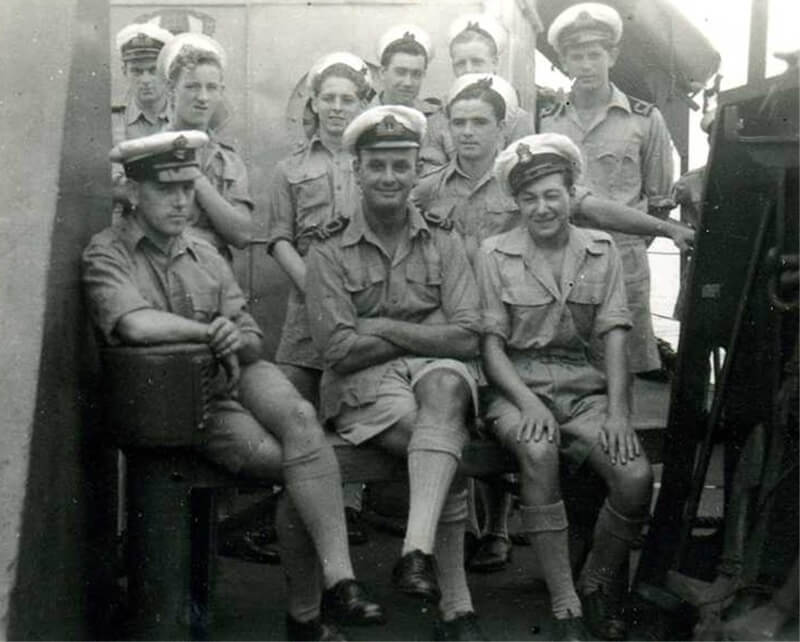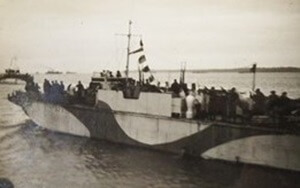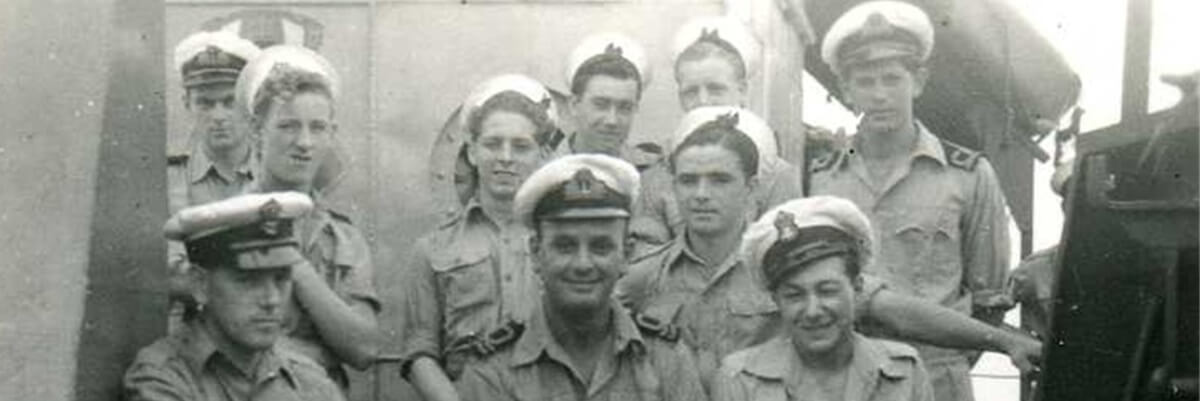by Peter Healy
“D-Day has come. Early this morning the Allies began the assault on the north-western face of Hitler’s European Fortress” announced BBC newsreader, John Snagge, on the evening of 6 June 1944.

Brian Healy, who lived in Amersham for 35 years, was the skipper of a landing craft which reached Normandy just after 9am that day. As it approached land, the bridge was hit by a shell. One commando was killed, and a young officer wounded in the eye. Under intense shell fire, the remaining troops were unloaded. As the vessel was pulling off the beach, a mine exploded under her bow. With the decks awash with water, Brian motored her slowly home for repairs and returned to France with more troops just two weeks later.
The Wavy Navy
29-year-old, Henry Brian Sealy entered basic Naval training in March 1942 at the shore establishment, HMS Dinosaur. When war broke out Brian was working in a reserved occupation, gas production, at the Gas Light and Coke Company in Westminster. Still living with his parents in Harrow he had enrolled as a fire warden and later as a civil defence warden. After shore training, he was posted for further training to the battleship HMS Howe which was then in Scapa Flow after a refit. On the Howe at the same time was The Hon Edward ‘Richard’ Curzon, the future 6th Earl Howe of Penn House who died in 1984.
It was while at sea on HMS Howe on 15 October that Brian was notified of his older brother Dennis’ death. Dennis Healy DSO of the RAF Volunteer Reserve, was the skipper of a Catalina flying boat in 210 Squadron, based in Oban. On a return flight from Northern Russia, Dennis was killed after an attack on the Catalina by a lone Junkers 88 and is buried in the Severomorsk Cemetery in Murmansk. The two brothers were extremely close but Brian had little time to grieve as he was working hard on his training as an Able Seaman.
In early 1943 Brian was transferred to HMS King Alfred, another shore-training establishment, this time for Navy Volunteer Reserve Officers. Instead of straight ‘brass rings’ that circled their cuffs VR officers had wavy ones and were often called the ‘wavy navy’.
Having opted for landing craft where he could be his own skipper, Brian was transferred to Landing Craft Infantry (Small) 518 where he trained until October 1943. He received a glowing testimonial from the Commander of HMS Tormentor, the shore base for training commandoes and landing craft crew to work together as part of Combined Operations, who described him as “capable and zealous”. A highly intelligent man he literally ‘sailed’ through courses in signalling, navigation and watchkeeping which served him well when he was put in command of his own landing craft.
LCI(S) 532
16 October 1943, Brian finally achieved his ambition at HMS Tormentor: his own command as skipper of LCI(S) 532 with the rank of Acting Temporary Sub Lieutenant, the lowest rank of Naval Officer. The LCI(S) 532 was a Fairmile H design made at the Collins Pleasurecraft Company on Oulton Broad, near Lowestoft.

532 was based at Warsash on the Hamble River, just off the entrance to Southampton Water. The boats were moored by Rising Sun Quay where today there is a monument to the D-Day landings. At low tide the narrow channel gave Brian and his crew excellent training experience for beaching on mainland Europe. Endless beach assaults were practised in the months leading up to D day whilst the commando units received appropriate training courses for the task ahead: Gunners were trained to fire their weapons from craft afloat at sea; drivers were shown how to waterproof their vehicles, manoeuvre them onto wet decks and drive them ashore through several feet of water; and medical staff rehearsed lowering stretcher cases into and out of boats.

D-Day
For Operation Overlord (its official name) 532 was part of Division III, commanded by Lieut. Commander Deslandes and allocated to Flotilla 201 under Commander Rupert Curtis. The task of Division III was to land 45 Royal Marine Commando regiment while Divisions I and II, 20 minutes ahead of III, landed 1st Special Services Brigade, known as Lord Lovat’s Scouts.
Just before D-Day, General Montgomery, who was commander-in-chief of the 21st Army group, issued a personal message to the 83,000 British and Canadian troops that landed on D-Day. Brian kept a copy amongst his personal papers, given to him by one of the 1000s of troops that 532 carried across the channel.
The bad weather of the 5th of June had delayed D-Day from the planned date to the following day. 532 left the Hamble and moored overnight at Stokes Bay before sailing to Normandy in the early hours of the 6th of June. The sea was still what sailors call ‘lumpy’ and the flat-bottomed landing craft would have been rolling from side to side all the way across causing severe nausea to the disorientated, anxious troops on board. When they arrived in Normandy three commandos had to be stretchered off because of seasickness.
As the invasion force moved across the channel they were protected by 1,200 warships. The landing craft were allocated to specific traffic lanes to avoid having to cross the routes of other ships on their way to 1 of the 5 Normandy beaches. 532 was one of 4,126 landing craft. In total there were 6,939 ships with 195,000 crew carrying 156,000 Allied troops.
Sword Beach
201 Flotilla had been allocated to a section of Sword Beach called Queen and further sub-division of Queen called Red. Sword Beach stretched from the mouth of the River Orne to the east of St-Aubin-sur-Mer. The initial assault at 07:25 hours was by two battalions to start clearing the beaches. There were 72% casualties in this first wave. Brigadier Lord Lovat’s Scouts were piped over the bow of their landing craft by Billy Millin who played “Blue bonnets over the Border” amongst other Scottish airs.
As 532 approached under heavy shelling, Brian was looking out for mines and metal traps ‘hedgehogs’ which the German’s had littered along the beach. Brian later recalled: “Tangle on the beach going in. Vision of a tank in the sea disabled with the voice of a wounded soldier coming from the open hatch calling for help. Tide rising. Nothing could be done”. Next time he had time to look “the tank was awash, the sea had poured into the open hatch, inmates presumably drowned”.
Once on shore the commandos came over the bows of the landing craft to the beach. The design of these landing craft meant that the troops, laden with firearms, ammunition and, in some cases, bicycles had to walk a narrow landing plank to the beach. Many fell off!
Damage
After being damaged by the mine explosion, 532 took refuge alongside HMS Frobisher, a British light cruiser which acted as ‘mother hen’ for the landing craft. The decks and troop bays were pumped out to make the landing craft more seaworthy before Brian motored slowly back across the channel accompanied by LCI(S) 535.

As 532 turned off Southampton Water towards Warsash, Brian met a launch skippered by Leading WREN ‘Jimmy’ Edwards who offered to tow him in. He told her “I’ve made it across the Channel; I think I can make it up the Hamble!”
After hasty repairs 532 returned to Sword Beach and continued to run a ferry service. It escaped further damage despite the constant shelling from inland artillery. For some weeks, the Germans contained the invasion within about a mile of the beach. However, on 25th July the Americans managed to breakout and Brian’s regular cross-channel trips began to decrease.
He was then redeployed to skipper a larger LCI(L) and went for training at combined operations headquarters in Ardrossan, Ayrshire and later served in Burma.
Amersham

When the war ended Brian proposed to WREN Jo Harper, who was serving as boat crew at Rising Sun Quay. The couple moved to Beech Grove, Amersham in 1946, later moving to Chesham Bois where they lived until 1981.
Sources
Brian Healy’s papers
The war records of Rupert Curtis, Brian’s LCI(S) commander. They kept in touch until Brian’s death in 1990. These records are now in Portsmouth Central Library and Peter visited them in 2017.
Voyager of the Winds by Kate Lance, a biography on Alan Villiers
The Imperial War Museum and its WWII digitised videos.

